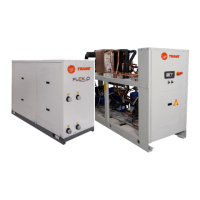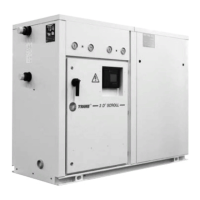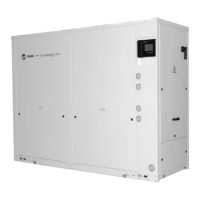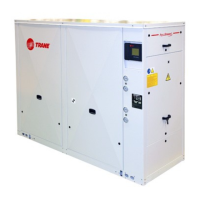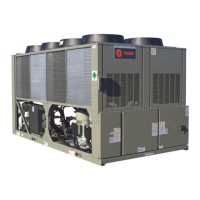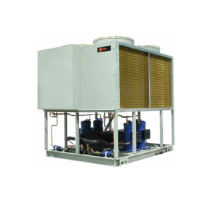40 CGWF-SVX01A-EN
Installation Mechanical
Refrigerant Piping (CCAF only)
Refer to the “Trane Reciprocating Refrigeration Manual” for refrigerant piping
selection information. Refrigerant pipe size selected must be within the velocity and
pressure drop limitations required for proper system operation. It is essential that
refrigerant piping be properly sized and applied since these factors have a significant
effect on performance.
NOTE: Use Type L refrigerant grade copper tubing only. The use of a lower grade
tubing can cause operating problems.
Liquid Line Components and Connections
Liquid line connections sizes and locations are shown in Figure 10 - Figure 11.
Thermostatic expansion valves, refrigerant sight glass, solenoid valves and schraeder
valves are standard components on CCAF liquid lines. A liquid line filter drier must be
installed for each circuit. Install a liquid line service valve in the liquid line to isolate
the drier for service.
Liquid Line Sizing
Trane recommends sizing the liquid line diameter as small as possible while
maintaining acceptable pressure drop. This will minimize the required refrigerant
charge and increase compressor life.
Liquid risers in a system an additional 0.5 psig pressure drop per each foot of vertical
rise. If the riser is length exceeds 15 feet, a larger diameter and/or shorter liquid line
may be required to provide required subcooling at the expansion valve. The line does
not have to be pitched. Basic liquid line sizing perimeters for these units are:
Liquid lines are not usually insulated. If, however, the line runs through an area of
high ambient temperature (i.e. boiler room), subcooling my drop below required
levels. Liquid line passing though these warm spaces should be insulated.
Discharge (hot gas) Lines
Pitch discharge lines in the direction of hot gas flow at the rate of 1/2-inch per each 10
feet of horizontal run. Discharge line sizing is based on required velocity to provide
good oil movement. Basic discharge line parameters are:
Liquid Velocity 100-250 fpm
Maximum allowable pressure drop 3-6 psig (1F)
Maximum allowable pressure drop 6 psig (1F) 6 psig (1F)
Maximum Velocity 3500 fpm
Minimum Velocity (at minimum load)
Horizontal lines 500 fpm
Vertical lines (up flow) 1000 fpm
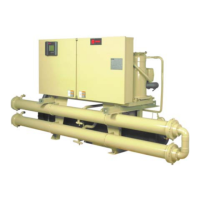
